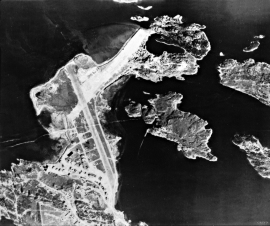Published: 31.01.2013 | Author: Nils Georg Brekke, Anders Bjarne Fossen
Herdla (Helge Sunde).
Numerous finds show that the settlement at Herdla goes back to prehistoric times, and the large estate at Herdla has enjoyed a central place in the nation’s history since High Middle Ages. As Ask, Herdla was part of the country estate Harald Hårfagre took over as he took command of the west of Norway.
In 1139 Herdla was ransacked by the kings Sigurd Slembe and Magnus Blinde, while the owner, Lakse-Pål (Salmon-Paul) was a court representative at Hamre in the Osterfjord. Filippus Simonsson, the son of the daughter of the legal representative Arne at Stårheim in Nordfjord and a nephew of the mighty Oslo bishop Nikolas Arnesson, was at home at Herdla when he was elected king of the baglars in 1207. In late Middle Ages Herdla became noble estate, while again reverting to the king during the Reformation.
In 1637 the estate became part of the properties of Crijin Hooft, the foremost merchant in Bergen, ship-owner and the main partner in “The Russian Rye Company”. He built a corn silo “Kornspeicher” on the farm as a storage depot for corn imported from Archangel. When the corn was to be sold to the city’ inhabitants, it was shipped in smaller lots to the sea stores at Nykirken in Bergen. In 1662 the farm Herdla was bought by the law speaker Hans Hannssøn Smith. He was ennobled with the name Lilienskiold and was amongst Bergen’s wealthiest men with large country estates in all counties in the west of Norway. Later on the farm was inherited by the son with the same name, who became county governor of Finnmark in 1684-1701, and is best known for his work Speculum Boreale, 1698.
Through the following centuries we encounter families with well-known names connected with Norwegian official appointments and trade at Herdla farm: Svanenhielm, Heiberg, Krüger and Konow. Since 1841 the farm has been the property of the family Bjørnstad.
Den tyske militærflyplassen på Herdla
British aerial photograph of the German military airport at Herdla. The photo is a spy photo from September 1944. On December 27 1941 Herdla airport was bombed by British planes to prevent the German air force from taking part in the “Måløy – raid” that took place at the same time.
- Garatun-Tjeldstø, G. (1972) Herdla - soga og folkeliv. I: Frå Fjon til Fusa: årbok for Nord- og Midthordland sogelag. Bergen, Sogelaget, s. 66-87.




